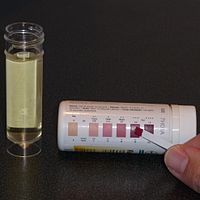
Photo from wikipedia
Abstract Background: We investigated the lipid-lowering efficacy and safety of coenzyme A (CoA) versus fenofibrate in Chinese patients with moderate dyslipidemia. Methods: A total of 417 subjects (aged 18–75 years) diagnosed… Click to show full abstract
Abstract Background: We investigated the lipid-lowering efficacy and safety of coenzyme A (CoA) versus fenofibrate in Chinese patients with moderate dyslipidemia. Methods: A total of 417 subjects (aged 18–75 years) diagnosed with moderate dyslipidemia (triglyceride 2.3–6.5 mmol/L) from 13 large cardiovascular centers in China were recruited and randomly divided into a fenofibrate group (n = 207), which received 200 mg of fenofibrate orally once daily, and a CoA group (n = 210), which received 400 mg of CoA orally once a day. Blood lipoproteins, liver and renal function, creatine kinase, and blood glucose were measured at baseline, and after 4 and 8 weeks of treatment. Results: The baseline triglyceride (TG) level in the fenofibrate group and the CoA group was 3.39 ± 0.99 mmol/L and 3.60 ± 1.11 mmol/L, respectively. After treatment for 4 and 8 weeks with fenofibrate, TG was reduced by 31.62% and 33.13%. In the CoA group, TG was reduced by 17.29% and 23.80%. Compared with baseline, total cholesterol (TC) was significantly decreased in both groups after either 4 or 8 weeks of treatment (p < .05). CoA increased high-density lipoprotein cholesterol (HDL-C) after 4 weeks of treatment, whereas it had no significant effect on HDL-C after 8 weeks of treatment. Low-density lipoprotein cholesterol (LDL-C) was not modified in either group. The incidence of side effects was significantly lower in the CoA group compared with the fenofibrate group (p < .05). Conclusions: Compared with fenofibrate, CoA has less effect on reducing plasma TG levels in subjects with moderate dyslipidemia. However, it has fewer adverse effects.
Journal Title: Current Medical Research and Opinion
Year Published: 2020
Link to full text (if available)
Share on Social Media: Sign Up to like & get
recommendations!